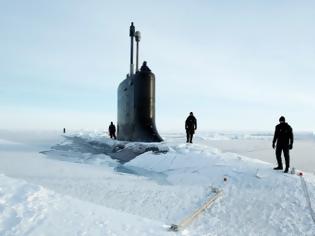2013-06-24 19:07:32

By failing to ratify the Law of the Sea treaty, the United States is missing out big time in the Arctic
U.S. Navy safety swimmers stand on the deck of the USS New Hampshire after it surfaced through thin ice in the Arctic Ocean. (Lucas Jackson / Courtesy Reuters)
The ice was never supposed to melt this quickly. Although climate scientists have known for some time that global warming was shrinking the percentage of the Arctic Ocean that was frozen over, few predicted so fast a thaw. In 2007, the Intergovernmental Panel on Climate Change estimated that Arctic summers would become ice free beginning in 2070. Yet more recent satellite observations have moved that date to somewhere around 2035, and even more sophisticated simulations in 2012 moved the date up to 2020. Sure enough, by the end of last summer, the portion of the Arctic Ocean covered by ice had been reduced to its smallest size since record keeping began in 1979, shrinking by 350,000 square miles (an area equal to the size of Venezuela) since the previous summer. All told, in just the past three decades, Arctic sea ice has lost half its area and three quarters of its volume.
It’s not just the ocean that is warming. In 2012, Greenland logged its hottest summer in 170 years, and its ice sheet experienced more than four times as much surface melting as it had during an average year over the previous three decades. That same year, eight of the ten permafrost-monitoring sites in
northern Alaska registered their highest-ever temperatures, and the remaining two tied record highs. Hockey arenas in northern Canada have even begun installing refrigeration systems to keep their rinks from melting.
Περισσότερα Foreign Policy
InfoGnomon
U.S. Navy safety swimmers stand on the deck of the USS New Hampshire after it surfaced through thin ice in the Arctic Ocean. (Lucas Jackson / Courtesy Reuters)
The ice was never supposed to melt this quickly. Although climate scientists have known for some time that global warming was shrinking the percentage of the Arctic Ocean that was frozen over, few predicted so fast a thaw. In 2007, the Intergovernmental Panel on Climate Change estimated that Arctic summers would become ice free beginning in 2070. Yet more recent satellite observations have moved that date to somewhere around 2035, and even more sophisticated simulations in 2012 moved the date up to 2020. Sure enough, by the end of last summer, the portion of the Arctic Ocean covered by ice had been reduced to its smallest size since record keeping began in 1979, shrinking by 350,000 square miles (an area equal to the size of Venezuela) since the previous summer. All told, in just the past three decades, Arctic sea ice has lost half its area and three quarters of its volume.
It’s not just the ocean that is warming. In 2012, Greenland logged its hottest summer in 170 years, and its ice sheet experienced more than four times as much surface melting as it had during an average year over the previous three decades. That same year, eight of the ten permafrost-monitoring sites in
northern Alaska registered their highest-ever temperatures, and the remaining two tied record highs. Hockey arenas in northern Canada have even begun installing refrigeration systems to keep their rinks from melting.
Περισσότερα Foreign Policy
InfoGnomon
ΜΟΙΡΑΣΤΕΙΤΕ
ΔΕΙΤΕ ΑΚΟΜΑ
ΠΡΟΗΓΟΥΜΕΝΟ ΑΡΘΡΟ
Tα μέτρα της τροχαίας για την επιστροφή των εκδρομέων
ΣΧΟΛΙΑΣΤΕ











![Περίεργο αξεσουάρ για να εντυπωσιάσετε τις γυναίκες! [photos]](https://images.newsnowgreece.com/45/452412/periergo-axesouar-gia-na-entyposiasete-tis-gynaikes-photos-1-124x78.jpg)



